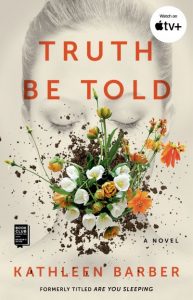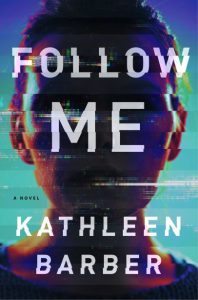Tips for Writing Multi-POV Novels with Distinct Voices
 Kathleen Barber’s debut novel Truth Be Told (originally published as Are You Sleeping) is the inspiration for the Apple TV+ series of the same name, which is produced by Reese Witherspoon’s Hello Sunshine and stars Octavia Spencer and Aaron Paul. Originally from Galesburg, Illinois, Kathleen is a graduate of the University of Illinois and Northwestern University School of Law, and a former attorney. She lives in Washington, DC, with her husband and son. Follow Me is her second novel.
Kathleen Barber’s debut novel Truth Be Told (originally published as Are You Sleeping) is the inspiration for the Apple TV+ series of the same name, which is produced by Reese Witherspoon’s Hello Sunshine and stars Octavia Spencer and Aaron Paul. Originally from Galesburg, Illinois, Kathleen is a graduate of the University of Illinois and Northwestern University School of Law, and a former attorney. She lives in Washington, DC, with her husband and son. Follow Me is her second novel.
We’re delighted to feature this piece by her!
Almost every piece of fiction I’ve ever written—from my debut novel Truth Be Told (originally published as Are You Sleeping) to my short stories to all my unpublished drawer monsters—has been written using the perspective of a single narrator. It’s a device that feels both comfortable and authentic to me, and it’s one that I enjoy reading as well.
But when I sat down to write my forthcoming novel, Follow Me, I decided to try something different. Rather than one narrator, I used three.
At first, it was a lot of fun. Instead of being stuck inside one character’s head through the entirety of a novel, I was able to bounce around through three separate and distinct heads. I enjoyed the exercise of imagining a single event through each POV and cataloguing the differences in their reactions. Perhaps most of all, I appreciated the freedom from being limited to reveal only what one character knows or perceives—with three different narrators to play with, I was able to clue the reader into things that the other narrators didn’t know.
And then I read a portion of my first draft and realized that all my characters sounded the same. I was dumbfounded. How could that be? They were such different individuals: a self-obsessed social media influencer, an ambitious but anxiety-ridden attorney, and a man so obsessed with a woman that he begins stalking her. They shouldn’t have sounded alike, and yet they did.
My first instinct was to consider the multi-POV draft a failed experiment and rewrite solely from the perspective of the “main” narrator. I was on the verge of doing so—I had a revised outline and everything—when I realized that each of the three perspectives was essential to the novel. For me to tell the story that I had set out to tell, I needed to figure out how to make these different narrators work.
 So I rolled up my sleeves and dug back into my manuscript, paying special attention to each character’s voice. I had assumed that the hardest part would be writing the male character as I am not and have never been a man (particularly an obsessed man), but, to my surprise, the part that gave me the most trouble was distinguishing between the two female characters.
So I rolled up my sleeves and dug back into my manuscript, paying special attention to each character’s voice. I had assumed that the hardest part would be writing the male character as I am not and have never been a man (particularly an obsessed man), but, to my surprise, the part that gave me the most trouble was distinguishing between the two female characters.
One of the challenges was keeping each character’s particular style of speech—the formulation of their sentences, the turns of phrase they favor, the exclamations they use—straight. This is especially important if any of your characters use phrasing that’s particularly unique (think about how silly it would seem to have multiple characters shout “Holy cats!”), but it’s something useful to keep in mind with more mundane phrases as well.
Of course, keeping your eye on character speech patterns if work you need to do in order to have believable dialogue; it’s not exclusive to stories told through multiple narrators. But when you’re in your narrators’ heads, you are responsible for their interior thoughts and visceral reactions as well. To that point, I noticed I kept having everyone’s stomachs clench—not only was it kind of cliché, it was repetitive and contributed to the characters all sounding the same. I went back through and made sure that each of the narrators responded to events differently.
It was difficult work. So difficult, in fact, that I was still catching mistakes in and making revisions to the book on my second pass pages, and I probably would have continued making minor changes to the voices right up until the actual publication if my publisher hadn’t cut me off.
I’m really pleased with the three different voices in Follow Me, but it was far from effortless. I’m sharing four things that I learned about writing multi-POV books along the way. I’d love to hear your thoughts in the comments!
Start with as clear an idea of your characters as possible. If you take the time to fully develop your characters and truly understand them before you ever put your fingers to the keys, you stand a better chance of maintaining their distinctness throughout your drafting. That said, I believe it’s inevitable that you discover more about your characters as you write. You will almost certainly have revisions to do per those new developments, but you can keep the total revisions to a minimum by starting with a clear idea of your characters.
Write (or edit) the scenes for one character at a time. I found it really helpful to write a number of scenes for one character in a row. That way, I stayed in the head of the character and was able to find their voice more easily. Of course, this worked for me because I don’t write my books in order—if you do, you might find that editing a number of scenes for one character in a row is useful.
Keep a log of phrases or tics specific to each character. I used the character sheets in Scrivener to keep track of things that each character would say, think, or feel, but it would be just as useful to keep a running log in Notes (or your favorite note-taking app) or a physical notebook.
Read aloud your work when you’re done. I think this is a great practice anytime you’ve completed something, but I found it especially useful when I was drafting a multi-POV book. Hearing your work is much different than reading it, and you may pick up on similarities in voice that you might otherwise have missed.
—
Find out more about Kathleen on her website https://kathleenbarber.com/
Connect with her on Facebook: www.facebook.com/kathleenbarberauthor
Connect with her on Twitter: www.twitter.com/katelizabee
Connect with her on Instagram: www.instagram.com/katelizabee
FOLLOW ME
 From the author of Truth Be Told (formerly titled Are You Sleeping)—now an Apple TV series of the same name—comes a cautionary tale of oversharing in the social media age for fans of Jessica Knoll and Caroline Kepnes’s You.
From the author of Truth Be Told (formerly titled Are You Sleeping)—now an Apple TV series of the same name—comes a cautionary tale of oversharing in the social media age for fans of Jessica Knoll and Caroline Kepnes’s You.
Everyone wants new followers…until they follow you home.
Audrey Miller has an enviable new job at the Smithsonian, a body by reformer Pilates, an apartment door with a broken lock, and hundreds of thousands of Instagram followers to bear witness to it all. Having just moved to Washington, DC, Audrey busies herself impressing her new boss, interacting with her online fan base, and staving off a creepy upstairs neighbor with the help of the only two people she knows in town: an ex-boyfriend she can’t stay away from and a sorority sister with a high-powered job and a mysterious past.
But Audrey’s faulty door may be the least of her security concerns. Unbeknownst to her, her move has brought her within striking distance of someone who’s obsessively followed her social media presence for years—from her first WordPress blog to her most recent Instagram Story. No longer content to simply follow her carefully curated life from a distance, he consults the dark web for advice on how to make Audrey his and his alone. In his quest to win her heart, nothing is off-limits—and nothing is private.
With “compelling, suspenseful” (Liz Nugent) prose, Kathleen Barber’s electrifying new thriller will have you scrambling to cover your webcam and digital footprints.
“Relevant and chilling, Follow Me is a compelling, cautionary tale about the lust for social media attention and the dangers of Internet exposure. A must-read!” — Wendy Walker, bestselling author of All Is Not Forgotten and The Night Before
“Follow Me is a gripping, chilling, and relevant deep dive into the dark and scary side of social media. Kathleen Barber masterfully keeps the reader guessing until the mind-blowing conclusion.”
— Robyn Harding, bestselling author of The Party
Category: How To and Tips


























Great article. I’m good at making my characters sound different in dialogue. Narrative is more difficult. I always strive for a deep POV and almost always write multi-POV stories. So I’m working on the narrative portion to figure out the best way to handle this.
I always strive for a deep POV and often write multiple POV. I do pretty good with keeping the dialogue unique, but narrative gives me fits. I’m still working on learning this technique.
I was just in the process of creating notes for my next series and totally understand. The idea for the story came to me when I was in the process of editing my books My Heart Sings Your Song and Where Have We Come and needed some creative time to get back into why I want to write. I too am struggling with the women’s voices. My book is alternate chapters and then all three voices will be heard in the last quarter of the book.
This feedback has confirmed that I need to create more notes and phrases to help me distinguish POV. Hadn’t really thought of tics yet.
Just a thought I read my last books to myself and caught some errors in dialogue, but this time around I’m using the audio button on Word and that has helped with the voices too.
In my forthcoming novel, Watermark, Book #1 of the Broken Bell Series, (pub date 5/5/20) I have two first person narrators who tell the story in alternating chapters. Distinguishing their voices was the most challenging aspect of writing this novel, but I felt it was necessary. I agree that reading them out loud helps in the editing process. I also gave sections to my writing group without telling them who was speaking. Their feedback was invaluable. The POV in the novel I’m currently writing is 3rd person limited, which allows for greater freedom with language, but I’m including some letters from one character to another in order to work in another POV. I think POV is the most important choice a writer has to make at the outset of a project.